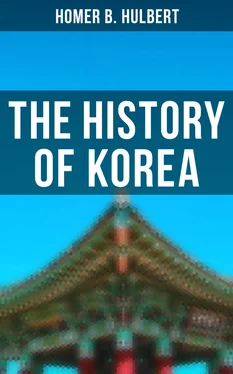Mo Yong-whang desired to invade China without delay but one of his relatives, Mo Yong-han, advised him to disarm Ko-gu-ryŭ and the U-mun tribe so that no possible enemy should be left in his rear when he marched into China. It was decided to attack Ko-gu-ryŭ from the north and west, but the latter route was to be the main one, for Ko-gu-ryŭ would be expecting the attack from the north. The strategem worked like a charm. Mo Yong-han and Mo Yong-p’ă led a powerful army by way of the sea road while General Wang-u led a decoy force by the northern route. The flower of the Ko-gu-ryŭ army, 50,000 strong, marched northward under the king’s brother Mu to meet an imaginary foe while the king with a few undisciplined troops held the other approach. As may be supposed, the capital fell speedily into the enemy’s hands but the king escaped. The Ko-gu-ryŭ forces had been successful in the north and might return any day, so the Yun forces were forbidden to go in pursuit of the king. To insure the good behavior of the king, however, they burned the palace, looted the treasure, exhumed the body of the king’s father and took it, together with the queen and her mother, back to the capital of Yŭn. With such hostages as these Yŭn was safe from that quarter. The next year the king offered his humble apologies and made a complete surrender, in view of which his father’s body and his queen were returned to him but his mother-in-law was still held. The same year Ko-gu-ryŭ moved her capital back to P’yŭng-yang. A few years laterby sending his son as substitute he got his mother-in-law out of pawn.
In 344 new complications grew up betweenSil-la and Japan. The Japanese having already obtained one Sil-la maiden for a queen made bold to ask for a royal princess to be sent to wed their king. This was peremptorily refused and of course war was the result. A Japanese force attacked the Sil-la coastguard but being driven back they harried the island of P‘ung-do and finally worked around until they were able to approach the capital. Finding the gates fast shut they laid siege to the city. But their provisions were soon exhausted and they were compelled to retire. Then the Sil-la forces swarmed out and attacked them in the rear and put them to an ignominious flight. Some years later the Japanese made a similar attempt but were outwitted by the Sil-la soldiers who made manikins of grass to represent soldiers, and the Japanese, seeing these, supposed that Sil-la had been reinforced and so retired from the contest.
Ko-gu-ryŭ had been so severely handled by her northern neighbor that she gave up for the time being her plans of conquest in that direction. Instead of this she turned her attention toward her southern neighbor Păk-je whose territory was a morsel not to be despised. About the year 360 she erected a fort at Ch’i-yang not far from the Păk-je capital which was thenat Nam-han. Into this she threw a large force consisting of 20,000 infantry and cavalry. They began a systematic plundering of Păk-je. The army of the latter, under the leadership of the Crown Prince, fell suddenly upon this fort and gained a victory, for, when the Ko-gu-ryŭ forces retired, they left 5,000 dead upon the field. Păk-je followed up this victory by throwing up a line of breastworks along the southern bank of the Han river to insure against a future surprise on the part of her unscrupulous northern neighbor. But Păk-je’s victories had shown her the weakness of Ko-gu-ryŭ and reprisals were therefore in order. She equipped an army of 30,000 men and penetrated the country of the enemy. She met no resistance until her army stood beneath the walls of P‘yŭng-yang. An attempt was made to storm the town, during which the king of Ko-gu-ryŭ was mortally wounded by an arrow, but the assault failed and the Păk-je army withdrew in good order. The king of Păk-je, elated over so many evidences of his growing power, promptly moved his capital across the Han River into Ko-gu-ryŭ territory. Some say he settled at Puk-han the great mountain fortress back of Seoul while others say he settled at Nam P’yŭng-yang or “South P’yŭng-yang,” by which is meant the present city of Seoul. Others still say it was at a point a short distance outside the east gate of Seoul. But in spite of the apparent successes of Păk-je it appears that the people were not satisfied. It may be that military exactions had alienated their good will, or it may be that they saw in these ambitious advances the sure presage of speedy punishment at the hands of Ko-gu-ryŭ; but whatever the cause may have been over a thousand people fled from Păk-je and found asylum in Sil-la. The king set aside six villages as their place of residence, and when Păk-je demanded to have them sent back answer was returned that Sil-la could not drive from her borders those who had sought asylum from the ill-treatment of Păk-je.
Three years before this, in372, the Chinese had gained a signal victory over the Yŭn kingdom and its king, Mo Yong-p’ung, had fled for safety to Ko-gu-ryŭ. It must have been his last resource, for he was likely to find little sympathy there. And so it proved for the king immediately seized him and sent him a captive to China.
The year 372 beheld an event of prime importance in the history of Ko-gu-ryŭ and of the whole peninsula. It was the introduction of Buddhism. It is probable that before this time some knowledge of Buddhism was current in Korea, but as it is eminently a sacerdotal institution but little more than indefinite reports could have been circulated previous to the coming of the monks. We are not told whether this was done at the request of Ko-gu-ryŭ or whether it was at the advice of Pu-gyŭn, one of the petty kings who then divided between them the north of China. Be that as it may, in 372 A.D. images of Buddha were brought by a monk, Sun-do, and also a Buddhist book called Pul-gyŭng. For this the king of Ko-gu-ryŭ returned hearty thanks and forthwith set his son and heir to learning the new doctrine. At the same time he gave an impetus to the study of the Confucian code. It is quite probable that to this new departure is due the fact that the next year the laws of the country were overhauled and put in proper shape for use. In 375 two great monasteries were built in the capital of Ko-gu-ryŭ. They were called Cho-mun and I-bul-lan. It should be noticed that the introduction of Buddhism into Korea was a government affair. There had been no propagation of the tenets of this cult through emmisariessent for the purpose, there was no call for it from the people. In all probability the king and his court were pleased at the idea of introducing the stately ceremonial of the new faith. In fact it was a social event rather than a religious one and from that date to this there has not been a time when the people of Korea have entered heartily into the spirit of Buddhism, nor have her most distinguished representatives understood more than the mere forms and trappings of that religion which among all pagan cults is the most mystical.
Păk-je was not long in following the example of her powerful neighbor. In the year 384 a new king ascended the throne of Păk-je. His name was Ch’im-yu. One of his first acts was to send an envoy to China asking that a noted monk named Mararanta be sent to Păk-je to introduce the Buddhist ritual. We notice that this request was sent to the Emperor Hyo-mu (Hsia-wu), the proper head of the Eastern Tsin dynasty, while Ko-gu-ryŭ had received hers at the hands of one of those petty kings who hung upon the skirts of the weakening dynasty and waited patiently for its dissolution. Each of these petty states, as well as the central government of the Tsin, was on the lookout for promising allies and such a request as this of Păk-je could scarcely be refused. Mararanta, whose name smacks of the south and who certainly cannot have been a Chinaman, was sent to the Păk-je capital. He was received with open arms. His apartments were in the palace where he soon erected a Buddhist shrine. Ten more monks followed him and Buddhism was firmly established in this second of the three Korean states. The greatest deference was paid to these monks and they were addressed by the honorific title To-seung. Sil-la received Buddhism some fifty years later.
Читать дальше









